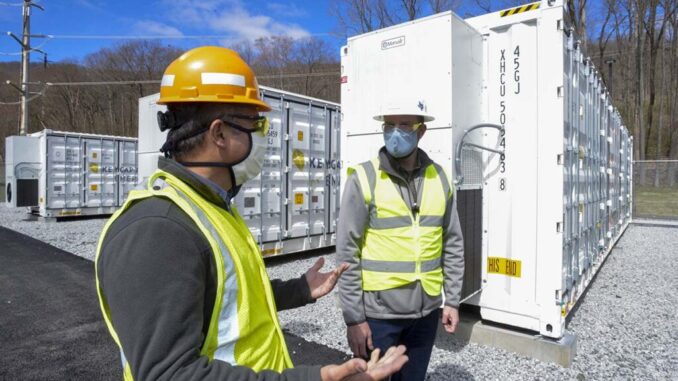
Energy storage could be a powerful asset in facilitating the transmission network upgrades required for New York’s transition to a low carbon electricity system, according to a new study.
It is widely recognised that along with the buildout of significant new renewable energy generation and energy storage capacity, the US state’s transmission network needs to be extended and modernised.
However, the new study, published by industry group NY-BEST, found that incorporating energy storage into the planned transmission network overhaul could aid those efforts from economic and technical standpoints.
The US state is on an ambitious policy path towards a carbon-free electricity sector by 2045. The recently published NY Climate Action Council Scoping Plan set out how to reach that goal, and an updated Energy Storage Roadmap (aka Roadmap 2.0) published just before the end of the year.
While the Roadmap, to be vetted and commented on by regulators before introduction, aims to enable New York to reach its target of 6GW energy storage in the state by 2030, the white paper study focuses specifically on the value of storage as a transmission asset (SATA).
Authors at utility infrastructure consultancy Quanta Technology were commissioned by NY-BEST to put the white paper together, taking an approach of examining other SATA efforts elsewhere in the world, and then directly applying three SATA use cases to the New York example.
SATA’s multiple benefits for the network quantified
The Grid Booster projects being carrying out by transmission network operators in Germany, and a transmission upgrade plan in the MISO grid region of the US were among the examples used for comparison.
While regular readers of this site may be familiar with how Grid Boosters will increase utilisation of Germany’s networks, they may not know that in MISO, a 2.5MW/5MWh battery storage system was found to be able to offer the same network benefit as a transmission line rebuild – at US$8.1 million versus US$11.3 million.
Under the three use cases hypothetically applied to New York, significant savings were found in the estimated capital cost of SATA against traditional wire-based solutions, offering further cost savings to the local area they were built in and spreading the benefit of easing network congestion in the wider New York Control Area – the area of the electric power system controlled by the New York Independent System Operator (NYISO).
For example, in Use Case #1 Quanta posited a 200MW/200MWh SATA battery system as an alternative to transmission wire solutions in terms of reducing congestion and cost-effectively improving the capability to transfer energy across the state.
The estimated cost of such a system would come in at US$120 million, while the capital costs of a wire-based solution for the same net benefit would cost about US$700 million.
Meanwhile, depending on where it would be sited, local congestion savings could add up to around US$9.9 million annually and NYCA-wide cost savings about US$13.1 million each year.
It matters because as the authors pointed out, the state’s Climate Protection and Community Leadership Act commits New York to decarbonisation and energy system modelling goals, but SATA is excluded from grid planning discussions by present rules and tariffs, the authors said.
Better line utilisation means less curtailment of renewables
It also matters greatly for New York because the state is home to both densely packed urban areas in and around New York City which experience consistently high demand for energy, but also the swathes of Upstate and more rural regions where the space to deploy new renewable energy assets – as well as the offshore regions where 9,000MW of offshore wind are targeted for deployment.
In an interview last year, CEO Jeff Bishop and New York project development lead Taylor Quarles from energy storage system developer Key Capture Energy told Energy-Storage.news about a proposed batteries-plus-wires project their company has been working to develop.
Key Capture Energy not only delivered New York State’s first grid-scale battery storage project in 2019, but also one of the state’s early examples of a SATA, non-wires alternative (NWA) battery energy storage system (BESS), albeit a relatively small one, for utility Orange and Rockland.
The proposed project, with Iberdrola subsidiary Avangrid, would be called Excelsior Connect and would feature a 150MW/600MWh as a central piece in a new “clean energy underground highway,” alongside a 108-mile underground HVDC line, taking a couple of thousand megawatts of renewable energy downstate towards the city, the KCE representatives explained in the August 2021 interview with Energy-Storage.news.
Such a project could reduce renewable energy curtailment, giving investors in clean energy technologies some added certainty, while reducing the cost of transmission. The battery system could also perform additional network services when not being fully utilised for transmission, such as ancillary services to maintain stable grid frequency.
As CEO Bishop also noted, many of New York’s legacy fossil fuel power plants were built in and near poorer and disadvantaged communities. Projects of this type could be a good way to address concerns of environmental justice and inequality that have been a stated aim of New York policymakers with the Climate Protection legislation.
NY-BEST’s white paper with Quanta Technologies can be read in full here.
Energy-Storage.news’ publisher Solar Media will host the 5th Energy Storage Summit USA, 28-29 March 2023 in Austin, Texas. Featuring a packed programme of panels, presentations and fireside chats from industry leaders focusing on accelerating the market for energy storage across the country. For more information, go to the website.



